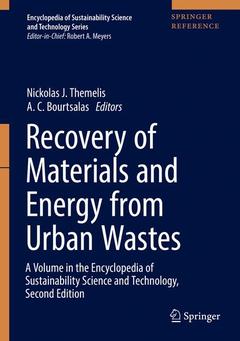Recovery of Materials and Energy from Urban Wastes, 1st ed. 2019 A Volume in the Encyclopedia of Sustainability Science and Technology, Second Edition Encyclopedia of Sustainability Science and Technology Series

Dr. Themelis obtained his B.Eng. (British Association Medal for Great Distinction) and Ph.D. degrees from McGill University (Montreal, Canada). In the first part of his career, he developed metallurgical processes for the extraction of copper and other metals, including his beingVice President of the Technology of Kennecott Corporation, the largest copper company in the world at that time. He
joined Columbia University in 1980 where he was Chair of the School of Mines and later first Chair of the new Department of Earth and Environmental Engineering. He is Founder of Columbia’s Earth Engineering Center and of the Global WTERT Council (GWC). Prof. Themelis is elected member of the US National Academy of Engineering and the coauthor of the waste management section in the 2014 International Panel for Climate Change (IPCC).
A. C. (Thanos) Bourtsalas is Adjunct Assistant Professor at the Earth and Environmental Engineering Department of Columbia University, and he is Manager of the Earth Engineering Center-Columbia (WTERT, US).
Dr. Bourtsalas graduated from the Earth and Environmental Engineering Department of Columbia University and did his Ph.D. at Imperial College London. He is involved in many advisory projects globally for the development of pre-feasibility and feasibility studies of integrated waste managements that achieve maximum, commercially viable, extraction and recycling of usable materials, combined with energy recovery from the remaining residual waste (Waste-to-Energy, WTE). He is the Principal Investigator for a project funded by the Columbia Global Centers and is related to the advancement of waste management in Latin America. He is Senior Advisor at an experts committee appointed and coordinated by the United Nations Economic Commission for Europe (UNECE) for the developmen
Provides an excellent example of industrial ecology where technology mimics the age-old ecological cycle
Introduces the importance of combining recycling and waste to energy (WTE) in attaining sustainable waste management
Describes in detail the dominant WTE technologies of moving grate and circulating fluid bed
Covers the use of non-recycled plastics and paper, and other “wastes” as alternative fuels in cement plants
Includes energy from both renewable and non-renewable waste sources
Includes supplementary material: sn.pub/extras
Date de parution : 01-2019
Ouvrage de 545 p.
17.8x25.4 cm
Disponible chez l'éditeur (délai d'approvisionnement : 15 jours).
Prix indicatif 316,49 €
Ajouter au panierThèmes de Recovery of Materials and Energy from Urban Wastes :
Mots-clés :
Waste to Energy; Hitachi Zosen Inova technology; Thermal Treatment of Waste; Sustainable Waste Management; Decreasing the Entropy of Solid Wastes; Increasing Metal Recovery; recycling construction waste; managing electronic waste; e-waste recycling methods; Municipal Solid Waste energy recovery; Extraction and reuse of materials; Waste to energy plants; Converting waste to energy; Building WTE plants
